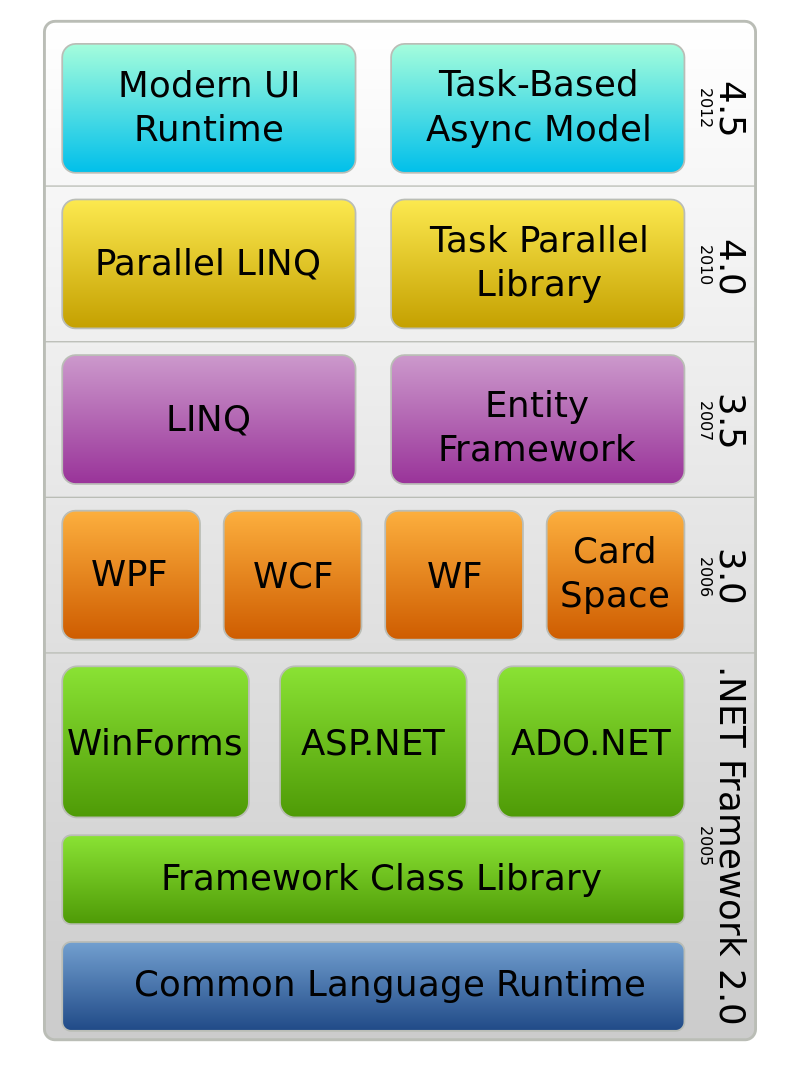.NET Framework (pronounced dot net) is a software framework developed by Microsoft that runs primarily on Microsoft Windows. It includes a large class library known as Framework Class Library (FCL) and provides language interoperability (each language can use code written in other languages) across several programming languages. Programs written for .NET Framework execute in a software environment (as contrasted to hardware environment), known as Common Language Runtime (CLR), an application virtual machine that provides services such as security, memory management, and exception handling. FCL and CLR together constitute .NET Framework.
FCL provides user interface, data access, database connectivity, cryptography, web application development, numeric algorithms, and network communications. Programmers produce software by combining their own source code with .NET Framework and other libraries. .NET Framework is intended to be used by most new applications created for the Windows platform. Microsoft also produces an integrated development environment largely for .NET software called Visual Studio.
.NET Framework started out as a proprietary framework, although the company worked to standardize the software stack almost immediately, even before its first release. Despite the standardization efforts, developers—particularly those in the free and open-source software communities—expressed their uneasiness with the selected terms and the prospects of any free and open-source implementation, especially with regard to software patents. Since then, Microsoft has changed .NET development to more closely follow a contemporary model of a community-developed software project, including issuing an update to its patent that promises to address the concerns.
.NET Framework family also includes two versions for mobile or embedded device use. A reduced version of the framework, .NET Compact Framework, is available on Windows CE platforms, including Windows Mobile devices such as smartphones. Additionally, .NET Micro Framework is targeted at severely resource-constrained devices.
History
Main article: .NET Framework version history
Microsoft started development of .NET Framework in the late 1990s, originally under the name of Next Generation Windows Services (NGWS). By late 2000, the first beta versions of .NET 1.0 were released.
In August 2000, Microsoft, Hewlett-Packard, and Intel worked to standardize Common Language Infrastructure (CLI) and C#. By December 2001, both were ratified ECMA standards. ISO followed in April 2003. The current version of ISO standards are ISO/IEC 23271:2012 and ISO/IEC 23270:2006.
While Microsoft and their partners hold patents for CLI and C#, ECMA and ISO require that all patents essential to implementation be made available under "reasonable and non-discriminatory terms". In addition to meeting these terms, the companies have agreed to make the patents available royalty-free. However, this did not apply for the part of .NET Framework not covered by ECMA/ISO standards, which included Windows Forms, ADO.NET, and ASP.NET. Patents that Microsoft holds in these areas may have deterred non-Microsoft implementations of the full framework.
On 3 October 2007, Microsoft announced that the source code for .NET Framework 3.5 libraries was to become available under the Microsoft Reference License (Ms-RSL). The source code repository became available online on 16 January 2008 and included BCL, ASP.NET, ADO.NET, Windows Forms, WPF, and XML. Scott Guthrie of Microsoft promised that LINQ, WCF, and WF libraries were being added.
On 12 November 2014, Microsoft announced .NET Core, in an effort to include cross-platform support for .NET, the source release of Microsoft's CoreCLR implementation, source for the "entire [...] library stack" for .NET Core, and the adoption of a conventional ("bazaar"-like) open-source development model under the stewardship of the .NET Foundation. Miguel de Icaza describes .NET Core as a "redesigned version of .NET that is based on the simplified version of the class libraries", and Microsoft's Immo Landwerth explained that .NET Core would be "the foundation of all future .NET platforms". At the time of the announcement, the initial release of the .NET Core project had been seeded with a subset of the libraries' source code and coincided with the relicensing of Microsoft's existing .NET reference source away from the restrictions of the Ms-RSL. Landwerth acknowledged the disadvantages of the previously selected shared source license, explaining that it made codename Rotor "a non-starter" as a community-developed open source project because it did not meet the criteria of an OSI-approved license.
Microsoft also produced an update to its patent grants, which further extends the scope beyond its previous pledges. Prior projects like Mono existed in a legal grey area because Microsoft's earlier grants applied only to the technology in "covered specifications", including strictly the 4th editions each of ECMA-334 and ECMA-335. The new patent promise, however, places no ceiling on the specification version, and even extends to any .NET runtime technologies documented on MSDN that have not been formally specified by the ECMA group, if a project chooses to implement them. This permits Mono and other projects to maintain feature parity with modern .NET features that have been introduced since the 4th edition was published without being at risk of patent litigation over the implementation of those features. The new grant does maintain the restriction that any implementation must maintain minimum compliance with the mandatory parts of the CLI specification.
Microsoft's press release highlights that the cross-platform commitment now allows for a fully open source, modern server-side .NET stack. However, Microsoft does not plan to release the source for WPF or Windows Forms

